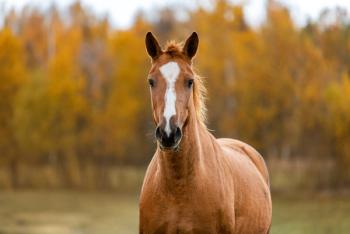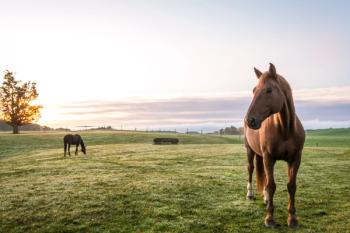
Derby accident spurs stronger look at track safety
Lexington, Ky. - Veterinarians played a key role in handling another high-profile racetrack tragedy - this time at the Kentucky Derby - and they're working with the racing industry in the aftermath to help improve Thoroughbred-racing safety and equine health and safety in general.
Lexington, Ky. — Veterinarians played a key role in handling another high-profile racetrack tragedy — this time at the Kentucky Derby — and they're working with the racing industry in the aftermath to help improve Thoroughbred-racing safety and equine health and safety in general.
The cheers of 157,770 fans when Big Brown crossed the finish line to win the 2008 Derby turned to gasps and tears when second-place finisher Eight Belles collapsed seconds later, suffering condylar fractures of both her front legs while pulling up. The scene was replayed on national television over several days.
With no chance of survival, the 3-year-old filly was euthanized by injection on orders of the track veterinarian. The horse had finished 3.5 lengths ahead of the third-place finisher, Denis of Cork, before the accident — worst in Derby history.
"Though it happened some distance from where our people were, we got there quickly on the ambulance and were perfectly prepared to deal with the reporters," says Larry Bramlage, DVM, MS, Dipl. ACVS, one of two American Association of Equine Practitioners (AAEP) "On Call" veterinarians on duty.
Bramlage, standing near NBC television announcers, answered questions from them and other reporters after communicating by radio with his "On Call" partner at the scene, Scott A. Hopper, DVM, MS, Dipl. ACVS. Bramlage and Hopper are surgeons at nearby Rood and Riddle Equine Hospital.
The AAEP provides "On Call" veterinarians at most major races to answer reporters' questions and give expert commentary. Bramlage handled a blitz of media interviews during and after race day.
"With the radio, I first heard one of the outriders close to the spot say the No. 5 horse went down," Bramlage tells DVM Newsmagazine. "After that, as long as it took for an ambulance going 40 mph to travel a half-mile — that's how long it took for Dr. Hopper to get there and for us to have something to tell the reporters. We were ready in minutes."
Besides Bramlage and Hopper, there were four veterinarians working for the State of Kentucky on the scene, two of them on the track and two behind the scenes for testing and examination purposes. Who makes the decision to euthanize?
"That decision is entirely in the hands of the track veterinarian," Bramlage explains. "The welfare of the horse is always the ultimate consideration. Normally the object would be to try to splinter the animal, load it on the ambulance and get it back to the barn to its own veterinarian and owner. But if the injury is serious enough to make that impossible, as it was in this case, and you can't handle her without undue suffering, then, under the law, when a horse is entered in a race, the owner gives up control of the final decision to the track veterinarian."
While galloping out after her finish, Eight Belles apparently first suffered a condylar fracture in her right front leg and tried to shift her weight to the left leg, causing it to fracture as well, Bramlage believes. "The left front fracture displaced and opened up. And of course when the skin opens infection sets in immediately, and that is one of the hallmarks, the huge threshold that determines whether there's a chance of survival."
By comparison, one day earlier in a preliminary race at Churchill Downs, a 4-year-old colt, Chelokee, dislocated his right front ankle, tearing all the ligaments connecting the back of the fetlock with the pastern joint, but the skin didn't open in that instance. Bramlage fused the horse's ankle May 5 in a fetlock arthrodesis procedure, and says the operation went well, giving the horse a good chance of recovery.
When the skin isn't broken, "the effective delivery of antibiotics is exponentially greater. The skin keeps contamination to a minimum," Bramlage explains.
That wasn't the case with Eight Belles, however. Bramlage said he's never seen bilateral fractures occur in that manner before — during pull-up after what appeared to be a perfect, strong race without any sign of distress or bumping against any other horse.
and preliminary findings confirmed the condylar fractures. "It (final report) may show additional injuries in both ankles as well," Bramlage says.
Less than a week after the accident, the Jockey Club commissioned a seven-member Thoroughbred Safety Committee to review "every facet" of equine health, including breeding practices, medication, racing rules, track surfaces and "to recommend appropriate actions."
"We'll look literally at everything and see if there's anything we're not doing or anything we can do better," says Bramlage, who was named to the panel.
Concurring with Bramlage on the panel's objective, AAEP President Dr. Eleanor Green tells DVM Newsmagazine: "One injury like this is too many. We care about all these horses. They are well cared for and have a good life, but we all need to look hard at ourselves and see what more we can do to protect them."
Bramlage and Kentucky Horse Racing Authority (KHRA) officials responded to statements from People for the Ethical Treatment of Animals (PETA), whose members held protest demonstrations at Churchill Downs and wrote a letter to the KHRA. The group wants an investigation, claiming Eight Belles "was doubtlessly injured before the finish," urging racing officials to suspend 20-year-old jockey Gabriel Saez for keeping the horse running and for excessive whipping. It said it might file cruelty charges against Eight Belles' principals.
The group also contends that fillies shouldn't run with colts and shouldn't train or race before they are 3 years old. It wants fewer races and an industrywide move to artificial or Polytrack surfaces already in use at some tracks. At press time, the group planned another protest at the Belmont Stakes in New York.
"I've looked at the (Eight Belles) video maybe 20 times. I saw no indication of anything wrong during the race," Bramlage says. "The jockey did everything correctly; the fact that the filly finished a strong second and was galloping well a quarter-mile beyond the finish shows that. But the muscles are tired at that point, coordination can deteriorate, and the horse may have its mind off racing by then, so these things can factor into it."
Fillies run the same, whether alongside colts or fillies, Bramlage says. "If you noticed, Eight Belles was bigger than many in the field, and she wasn't bumped by anyone. She ran a time very comparable to her previous race."
As for training or racing before age 3, "The data show that horses that do so at 2 years old have more starts and more success than those who wait until age 3," Bramlage says. "And findings from the two recent summits (Welfare and Safety of the Racehorse Summits, sponsored by the Jockey Club) found little difference in injuries; in fact, those trained starting at age 2 have fewer injuries. You'd expect that. If you let bone-formation apparatus atrophy after growth, you'd have to re-create it, and that's not ideal. To say they shouldn't participate until age 3 would be like telling people they shouldn't engage in sports until they get to the college level. That's ludicrous."
While Barbaro's injury in the 2005 Preakness, and his death eight months later from laminitis, spurred the installation of synthetic surfaces to replace some dirt tracks, the research on their effect is ongoing and incomplete, Bramlage says.
Tracks that have gone artificial so far include Keeneland, Santa Anita, Arlington Park, Hollywood Park, Golden Gate Fields, Del Mar, Turfway and Presque Isle.
Veterinarians at 34 tracks reported 1.47 fatalities per 1,000 starts on artificial surfaces during the last nine months, compared with 2.03 fatalities per 1,000 starts on dirt tracks.
"The unified injury-reporting system Dr. Mary Scollay (veterinarian at Florida's Gulfstream track) started last year is working well, providing more consistent and uniform data, so in a year or so we'll have enough to make a fully educated decision on track surfaces," Bramlage says.
"Another issue is that the durability of racehorses is declining," Bramlage says. "Society has changed to the point that everything is event-driven. Instead of looking at the total season in most sports, the focus seems to be on the big events, like the Super Bowl, the NCCA finals, World Series and so on. That's the centerpiece, and it's become the same in racing. People want their horses to get in the Derby and other spotlight events, and they pay a premium for it. So now you see horses that maybe were brilliant on a few occasions are now sires. Before all of this, horses had more starts and made more money actually racing. Longevity and racing durability were important, but that's less true today. We need to raise awareness of that, even though we can't force people to select horses for durability."
The National Thoroughbred Racing Association (NTRA)'s board of directors says it will conduct a similar review of policies and health and safety issues. "It is clear that the status quo is not an option, and we need to bring a renewed sense of urgency to these initiatives," says Alex Waldrop, NTRA president and CEO.
KHRA officials say they, too, will continue to look at all issues, including track surfaces, that Eight Belles' rider handled the whip properly for control and direction and that there is no scientific evidence to support reducing the number of races.
Newsletter
From exam room tips to practice management insights, get trusted veterinary news delivered straight to your inbox—subscribe to dvm360.




